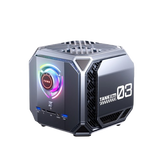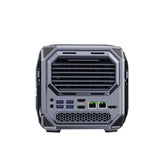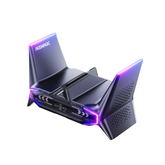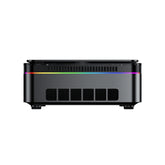DDR4 vs DDR5 RAM: Comprehensive Comparison Guide

In modern computer systems, DDR memory (Double Data Rate Synchronous Dynamic Random Access Memory) plays a crucial role, directly affecting device operation speed and overall performance. As technology continues to evolve, DDR memory has progressed from the earlier DDR3 to the widely discussed DDR4, and now the latest generation, DDR5. Currently, the comparison between DDR4 vs DDR5 has become an important reference for many users when upgrading memory, especially when choosing between DDR5 vs DDR4 RAM. This article will delve into the differences in performance, power consumption, and capacity between DDR4 and DDR5, helping you make an informed upgrade decision.
What are DDR4 and DDR5 Memory?
Introduction to DDR4
DDR4 (Double Data Rate 4 Synchronous Dynamic Random Access Memory) was officially launched in the second quarter of 2014 as the successor to DDR3. Compared to its predecessor, DDR4 boasts significant improvements in module density, data transfer rates, and energy efficiency, supporting single DIMM capacities of up to 64 GB. It is widely used in various computing devices, including desktops, laptops, and servers. DDR4 operates at a voltage of 1.2V, lower than DDR3's 1.5V, which not only enhances data processing speeds but also effectively reduces power consumption and heat generation.
Introduction to DDR5
DDR5 (Double Data Rate 5 Synchronous Dynamic Random Access Memory) represents the latest generation of memory technology, designed to further enhance memory bandwidth and capacity while lowering power consumption to meet modern computing demands. DDR5 has achieved several technical breakthroughs, including data transfer rates of up to 8 GT/s, maximum DIMM capacities of 512 GB, and integrated voltage regulation. These advancements make DDR5 significantly superior to DDR4 in terms of performance, stability, and energy efficiency, making it suitable for high-performance desktops, laptops, and data centers that require extensive memory support.
DDR4 vs DDR5: Key Technical Parameter Comparison
Performance Comparison
In terms of performance, DDR5 memory significantly outperforms DDR4 when it comes to speed and bandwidth. DDR5 has a maximum transfer rate of up to 8400 MT/s, which provides nearly a threefold bandwidth increase compared to DDR4's 3200 MT/s. This improvement allows DDR5 to handle large amounts of data more efficiently.
As a result, DDR5 is particularly suitable for applications that demand high memory bandwidth, such as high-end gaming, video editing, and data analysis. Moreover, despite DDR5's higher frequency, its latency is similar to that of DDR4 and may even be slightly improved in certain cases.
This means that in practical use, DDR5 can provide robust data processing capabilities while maintaining low latency. Performance tests have shown that systems using DDR5 excel in multitasking and high-load applications, significantly enhancing overall system responsiveness and processing efficiency.
Capacity and Density
When it comes to memory capacity and density, DDR5 also showcases notable advantages. The maximum capacity of a single DDR5 DIMM can reach 128 GB, which is four times that of DDR4. This is particularly important for high-performance computing, servers, and data centers that require large-scale memory support.
Higher memory density means that systems can accommodate more memory modules, further increasing total memory capacity to meet the growing demands of future applications. Additionally, DDR5's module design has been optimized with more efficient packaging technology and dense chip arrangements.
These enhancements improve both the storage capacity and cooling performance of memory modules, ensuring stable operation under high-load conditions. Overall, these design improvements not only enhance the memory's capacity but also provide greater possibilities for system scalability and flexibility.
Power Consumption and Efficiency
In terms of power consumption and efficiency, DDR5 significantly reduces energy usage through various technical enhancements. DDR5's operating voltage is lowered to 1.1V, compared to DDR4's 1.2V, which further decreases power consumption. This is particularly crucial in large-scale memory configurations, as it can substantially reduce overall system power consumption and heat dissipation needs.
Additionally, DDR5 memory modules incorporate a Power Management Integrated Circuit (PMIC), allowing for more efficient power management. This enables the memory to operate stably at lower voltages, which not only improves energy efficiency but also extends the system's lifespan and reduces reliance on cooling solutions.
However, it's important to note that because DDR5 modules have integrated more complex power management technologies, they may generate slightly more heat than DDR4 at the same voltage. Therefore, efficient cooling solutions are crucial for maintaining high-performance operation. For instance, technologies like CORSAIR’s DHX cooling solution are utilized in DDR5 memory modules to effectively disperse heat, ensuring stability under high loads.
Compatibility: Can DDR4 Upgrade to DDR5?
In terms of compatibility, there are significant differences between DDR4 and DDR5 that prevent direct upgrades between the two. First, DDR5 utilizes different physical interfaces and voltage standards. This means that existing motherboards and CPUs that support DDR4 cannot accommodate DDR5 memory modules.
To upgrade to DDR5, users will need to change their motherboard and may also require a compatible DDR5 processor. This adds complexity to the upgrade process and incurs additional hardware costs.
Moreover, from a financial standpoint, DDR5 memory and compatible motherboards are currently more expensive. It is essential for budget-conscious users to weigh the performance improvements against the costs of hardware replacement before deciding to upgrade.
However, as DDR5 technology becomes more widely adopted and production costs decrease, the transition from DDR4 to DDR5 is expected to become more economical and straightforward. For users seeking the latest performance and future scalability, DDR5 is undoubtedly the more attractive option.
On the other hand, for those with limited budgets or existing systems that do not yet exhibit performance bottlenecks, continuing to use DDR4 might be the more practical and cost-effective choice.
Key Parameter Comparison of DDR4 and DDR5
| Parameter | DDR4 SDRAM | DDR5 SDRAM |
|---|---|---|
| Release Date | Q2 2014 | 2020 |
| Operating Voltage | 1.2V | 1.1V |
| Transfer Rate | 1600–5000 MT/s | Up to 8400 MT/s and higher |
| Max DIMM Capacity | 64 GB | 128 GB |
| Architecture | Single Channel | Dual Independent Channels |
| ECC Support | Optional Module | On-die ECC and optional ECC modules |
| Power Management | Motherboard-based | Integrated Voltage Regulator |
Extended reading: Single Channel vs Dual Channel RAM: Understanding the Impact on Performance
What Are the Visual Differences Between DDR5 and DDR4 RAM?
When upgrading memory, it’s important to consider not only technical parameters such as performance, capacity, and power consumption but also the visual differences between DDR4 and DDR5 memory. Understanding these aesthetic differences can aid users in properly installing memory modules and selecting the right type for their systems.

Pin Count: Both DDR4 and DDR5 desktop DIMM memory modules have a 288-pin design, indicating that they appear similar in length and pin layout. However, despite having the same pin count, their physical interfaces are not compatible.
Notch Position: The notch positions on DDR4 and DDR5 memory modules are different, designed to prevent users from inserting incompatible memory sticks into the wrong slots. The notch on DDR5 memory is slightly offset compared to that of DDR4, meaning that even though both modules share the same pin count, they cannot be interchanged in slots of different generations.
Power Management Module: DDR5 memory modules integrate a voltage regulation module (PMIC), which is absent in DDR4. This integrated design leads to differences in the PCB (printed circuit board) layout; DDR5 memory sticks usually have additional capacitors and regulation circuits on one side or in specific locations. The presence of these components not only affects the thickness of the memory sticks but may also alter their overall appearance.
Heatsink Design: Due to the increased power management features of DDR5 memory modules, they generate more heat compared to DDR4. Therefore, the heatsink design for DDR5 focuses more on heat dissipation efficiency. Many DDR5 modules are equipped with larger, more complex heatsinks, and some even feature a full-cover design to maintain stable operating temperatures under high loads. In contrast, DDR4 memory sticks tend to have simpler heatsink designs that primarily focus on enhancing overall cooling performance.
Is It Worth Upgrading to DDR5 RAM?
Upgrading to DDR5 memory is reasonable in various cases, primarily depending on the specific needs of the user and any performance bottlenecks in the current system. If you are building or upgrading a high-performance computing system, such as a gaming rig, content creation workstation, or server, the higher frequency and bandwidth of DDR5 can notably enhance overall system performance.

Moreover, the increased memory capacity offered by DDR5 is also a significant advantage for users handling large datasets or running memory-intensive applications. As software and games increasingly demand more memory, adopting DDR5 early can prepare you for future performance needs. However, for users whose current systems run smoothly without the need for extreme performance boosts, DDR4 remains a cost-effective choice.
For Gamers: DDR4 or DDR5?
For gamers, the choice between DDR4 and DDR5 depends on specific gaming requirements and budget. DDR5 provides higher bandwidth and faster speeds, enabling smoother experiences in high frame rate and low latency gaming environments, particularly in modern large-scale games that require rapid loading of extensive data.
However, most current games have not fully tapped into the potential of DDR5 memory requirements, so for budget-conscious players, DDR4 can still deliver excellent gaming performance. Additionally, DDR5 memory is relatively expensive, and gamers should weigh the performance improvements against the cost when deciding to upgrade. If you plan on long-term system upgrades or wish to avoid replacing memory in the next few years, opting for DDR5 may be a wise investment.
For Content Creators: Does DDR5 Really Enhance Efficiency?
Content creators, such as video editors, 3D modelers, and graphic designers, often need to handle large datasets and complex computational tasks. The higher bandwidth and greater capacity of DDR5 memory can significantly enhance workflow efficiency. For instance, in 4K video editing or rendering complex 3D models, the speed of DDR5 can reduce data transfer bottlenecks, speeding up file loading and rendering processes.
Furthermore, the increased capacity of DDR5 allows creators to run more applications and handle larger project files simultaneously without a drop in performance. Therefore, for professional content creators, upgrading to DDR5 can improve work efficiency as well as enhance overall productivity and creative experience.
For Average Users: Considering Cost-Effectiveness
For the average user, the main considerations for a memory upgrade typically revolve around cost-effectiveness and actual needs. DDR4 memory, with its mature technology and lower prices, continues to meet daily computing requirements such as web browsing, office applications, and light entertainment.
The performance of DDR4 is sufficient for most everyday tasks, and it is also more stable and widely available in terms of system compatibility. Thus, for budget-conscious users or those without special memory performance needs, continuing to use DDR4 is a more economical choice. However, if you plan to undertake other hardware upgrades in the near future or wish to maintain good performance in the coming years, opting for DDR5 can also be seen as a forward-looking investment.
FAQs
Can I put DDR5 RAM in a DDR4 slot?
No, you cannot put DDR5 RAM in a DDR4 slot. DDR4 and DDR5 memory modules have different physical interfaces and notch positions, which prevent them from being compatible with each other.
Is DDR5 better than DDR4 for gaming?
Yes, DDR5 is generally better than DDR4 for gaming, primarily due to its higher bandwidth and faster speeds. These performance enhancements allow for smoother gameplay, particularly in resource-intensive games that require rapid data transfer.
What is the difference between DDR4 and DDR5 memory speeds?
The primary difference between DDR4 and DDR5 memory speeds lies in their data transfer rates. DDR4 typically operates at speeds ranging from 1600 MT/s to 5000 MT/s, while DDR5 can achieve speeds starting at 4800 MT/s and going up to 8400 MT/s or even higher. This increase in speed translates into better overall performance, especially in demanding applications.
How much faster is DDR5 vs DDR4?
DDR5 can be significantly faster than DDR4, with a performance increase of up to 70% in terms of maximum data transfer rates. For instance, while DDR4 peaks at around 5000 MT/s, DDR5 reaches speeds of 8400 MT/s or more.
Conclusion
In the comparison between DDR4 vs DDR5, DDR5 stands out with its higher transfer rates, increased memory capacity, and lower power consumption, significantly enhancing memory performance and efficiency. This makes it particularly suitable for gamers, content creators, and users with high-performance computing needs. However, the higher costs and compatibility limitations of DDR5 have prevented it from becoming mainstream among budget-conscious users or those with less demanding requirements. For users seeking future scalability and top-tier performance, upgrading to DDR5 is a worthwhile choice. Meanwhile, for everyday use, DDR4 continues to offer a cost-effective and reliable solution.







Leave a comment
Please note, comments need to be approved before they are published.